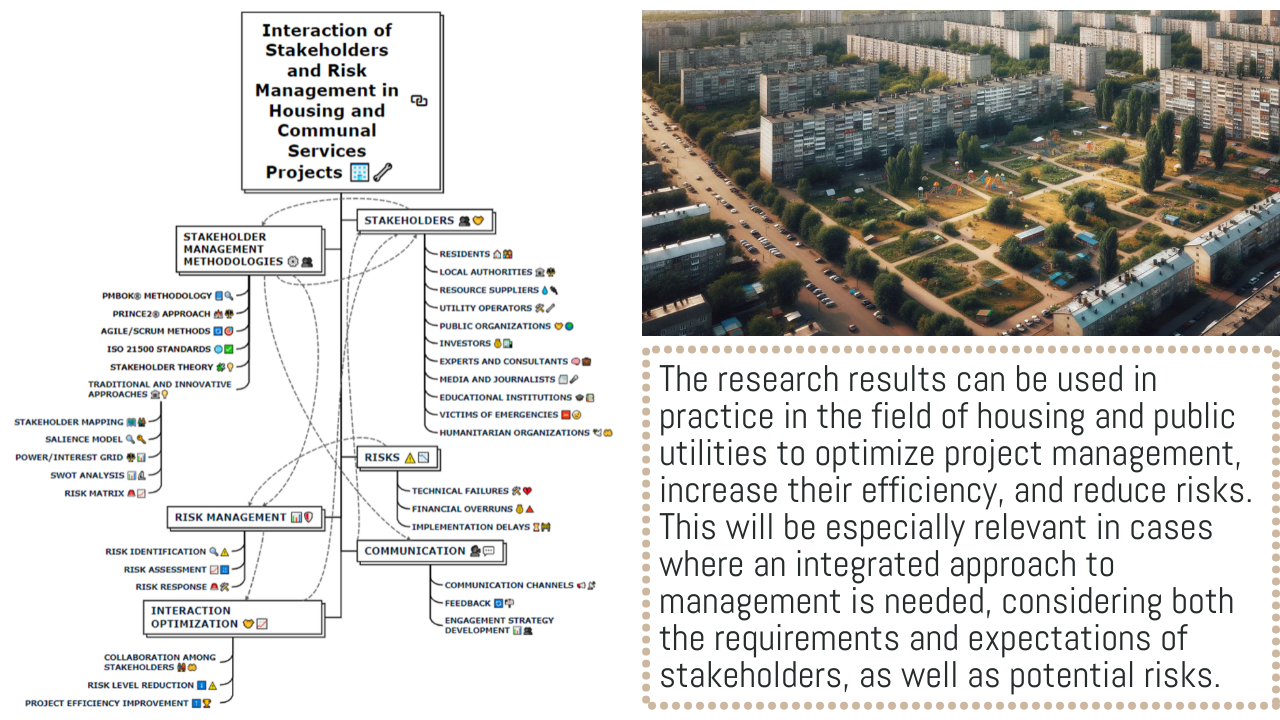Integration of stakeholder management and risk management methods in projects of housing and communal services providers
DOI:
https://doi.org/10.15587/2706-5448.2024.301995Keywords:
project optimization, stakeholder analysis, project management, risk management, stakeholder interaction, risk modelingAbstract
The object of research is stakeholder and risk management processes in the projects of housing and communal services providers. In conditions of constant change and uncertainty, such management becomes key to ensuring the success and sustainability of projects in this area. The problem addressed by the study is the development and analysis of an integrated model that combines stakeholder management with risk management, with an emphasis on innovation and performance improvement.
The essence of the obtained results is the identification of key points of interaction between stakeholders and risks, as well as the development of complex strategies for their effective management. The model is based on a combination of qualitative and quantitative methods of analysis, including structural-logical analysis, SWOT analysis, as well as the use of expert evaluation methods.
The results are explained by the need for a deeper integrated approach to stakeholder and risk management, especially in the context of housing and communal services (HCS), where the interaction between these elements directly affects the success of projects. This approach allows not only to identify potential problems at an early stage, but also to respond to them more effectively.
The innovativeness of the proposed model lies not only in its comprehensive approach to the analysis and management of stakeholders and risks, but also in the possibility of its scaling and adaptation to various conditions and projects in the field of housing. The application of this model includes the intensive use of modern analytical tools, which contributes to more accurate forecasting of risks and more effective solving of problems related to stakeholders. This, in turn, allows utilities providers to increase the quality and reliability of the services provided, strengthening trust and satisfaction among users. Also, the model provides for the active involvement of stakeholders in the project management process, which ensures greater openness, transparency of actions and the ability to quickly adapt to changing market conditions.
The research results can be used in practice in the field of housing and public utilities to optimize project management, increase their efficiency, and reduce risks. This will be especially relevant in cases where an integrated approach to management is needed, considering both the requirements and expectations of stakeholders, as well as potential risks.
References
- Chernenko, Yu. V. (2023). Modeli ta metody protyryzykovoho upravlinnia proiektamy rozvytku provaideriv zhytlovo-komunalnykh posluh. Kyiv, 255.
- Gnan, L., Hinna, A., Monteduro, F., Scarozza, D. (2011). Corporate governance and management practices: stakeholder involvement, quality and sustainability tools adoption. Journal of Management & Governance, 17 (4), 907–937. doi: https://doi.org/10.1007/s10997-011-9201-6
- Brown, R. E. (2017). Electric power distribution reliability. Boca Raton, 504. doi: https://doi.org/10.1201/9780849375682
- Florio, C., Leoni, G. (2017). Enterprise risk management and firm performance: The Italian case. The British Accounting Review, 49 (1), 56–74. doi: https://doi.org/10.1016/j.bar.2016.08.003
- Haynes, P. (2015). Managing complexity in the public services. London: Routledge, 178. doi: https://doi.org/10.4324/9781315816777
- Bös, D. (1994). Pricing and price regulation: an economic theory for public enterprises and public utilities. Bonn. doi: https://doi.org/10.1016/c2009-0-10348-3
- Cuppen, E., Bosch-Rekveldt, M. G. C., Pikaar, E., Mehos, D. C. (2016). Stakeholder engagement in large-scale energy infrastructure projects: Revealing perspectives using Q methodology. International Journal of Project Management, 34 (7), 1347–1359. doi: https://doi.org/10.1016/j.ijproman.2016.01.003
- Akhmouch, A., Clavreul, D. (2016). Stakeholder Engagement for Inclusive Water Governance: “Practicing What We Preach” with the OECD Water Governance Initiative. Water, 8 (5), 204. doi: https://doi.org/10.3390/w8050204
- Dymchenko, O. V., Sukhonos, M. K., Slavata, D., Prasol, V. M., Velychko, V. V. (2014). Features and controversies of housing and utilities development as an integral system. Komunalne hospodarstvo mist, 117, 123–130. Available at: https://bit.ly/3U4QL4b
- Lukyanov, V. I. (2017). The Analysis of the Current State and Trends in the Development of the Housing and Utilities Infrastructure in Regions of Ukraine. Problemy ekonomiky, 4, 206–211. Available at: https://bit.ly/3tZRvgq
- Shvydanenko, H. O., Boichenko, K. S. (2015). Rozvytok pidpryiemstva: stratehichni namiry, ryzyky ta efektyvnist. Kyiv: KNEU, 231. Available at: https://bit.ly/429sADC
- Smokova, T. M. (2021). Ryzyko-oriientovane upravlinnia intehratsiieiu v proiektakh transportno-lohistychnoi infrastruktury. Odesa. Available at: https://bit.ly/437A6iW Last accessed: 07.03.2024

Downloads
Published
How to Cite
Issue
Section
License
Copyright (c) 2024 Yuri Chernenko, Pavlo Teslenko

This work is licensed under a Creative Commons Attribution 4.0 International License.
The consolidation and conditions for the transfer of copyright (identification of authorship) is carried out in the License Agreement. In particular, the authors reserve the right to the authorship of their manuscript and transfer the first publication of this work to the journal under the terms of the Creative Commons CC BY license. At the same time, they have the right to conclude on their own additional agreements concerning the non-exclusive distribution of the work in the form in which it was published by this journal, but provided that the link to the first publication of the article in this journal is preserved.







